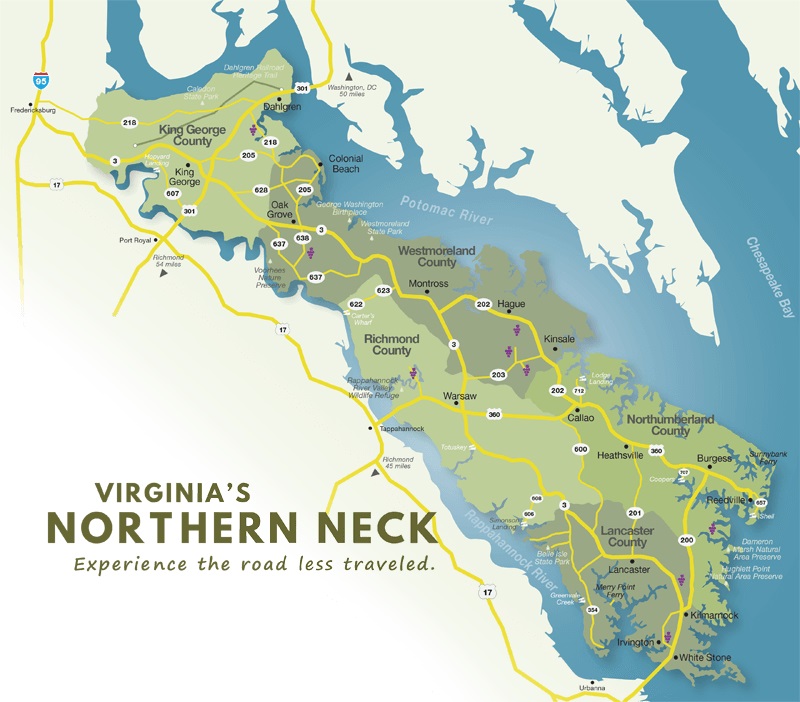Northern Neck

Town Links Irvington Kilmarnock White Stone Lancaster
NORTHERN NECK
Lancaster County
Lancaster County was established in 1651 from Northumberland and York counties. It was home to Robert King Carter in the 18th century, and remaining buildings from that time include Christ Church and St. Mary’s, White Chapel. Other historic attractions open to the public include the Lancaster Courthouse Historic District including the Mary Ball Washington Museum and Library, Belle Isle State Park, and the Village of Morattico Historic District. The most densely populated county in the Northern Neck, Lancaster County offers a unique combination of water life, history, natural beauty and culture for visitors and residents alike. The county edges on the Rappahannock and Corrotoman rivers, Carter Creek, and multiple creeks flowing into the Chesapeake Bay. The quaint town of Irvington houses the Tides Inn and Premier Sailing, the shops, Steamboat Museum, Farmer’s Market, Fourth of July parade, Rappahannock River Yacht Club, Hope & Glory Inn, and the Dog & Oyster Vineyard. Kilmarnock, which finds its namesake in Kilmarnock, Scotland offers a wide variety of stores and unique shops, restaurants and a festive Christmas parade through downtown. White Stone highlights include Windmill Point, White Stone beach, River Market – a gourmet deli, the Old Farm Truck and Willaby’s – a restaurant with a view of the Rappahannock River. Enjoy nature walks, boating and summer concerts at Belle Isle State Park. Learn more.Northumberland County
The area was occupied at the time of English settlement by the Algonquian-speaking historic tribes of the Wicocomico and Chickacoan. The county was created by the Virginia General Assembly in 1648 during a period of rapid population growth and geographic expansion. Settlement began in this area of the Northern Neck around 1635. Originally known as the Indian district Chickacoan, the area was first referred to as Northumberland in the colonial records in 1644. The following year, John Mottrom served as the first burgess for the territory in the House of Burgesses, which met at the capital of the Virginia Colony at Jamestown. The colonial court ordered the two tribes to merge and by 1655, assigned them a reservation of 4,400 acres (18 km2) near Dividing Creek, south of the Great Wicomico River.[3] By the early 1700s, the Wicocomico tribe was greatly reduced, and English colonists took control of their lands. They were believed to be extinct as a tribe as, landless, they disappeared from the historical record. Descendants of the last weroance are working to regain recognition as a tribe, the Wicocomico Indian Nation. Photo Credit from www.northernneck.org. Learn more.Richmond County
Richmond County, Virginia was formed in 1692 from old Rappahannock County. There is no consensus on the origin of Richmond County’s name, but it has been accepted that the county was named for the First Duke of Richmond, cousin to King William and Queen Mary. It is believed that Richmond County was inhabited by the first Indians, who migrated to hunt and gather food for their small, mobile families, more than 10,000 years ago during the Paleo-Indian period in 11,000 B.C. Artifacts from this time have been found around the county. Richmond County is located in the heart of the Northern Neck of Virginia, where it lies on the north side of the Rappahannock River. Its 192 square miles of community is within one hour’s drive of the city of Richmond, Virginia and within two hours’ drive of Washington D.C. Throughout its existence, farming, fishing, and forestry have formed the backbone of the county’s economy. Serving as the crossroads of U.S. Route 360 and State Route 3, the county seat of Warsaw is currently the headquarters for many regional government agencies as well as a regional community college, vocational center, and jail. Learn more.Westmoreland County
As originally established by the House of Burgesses from Northumberland County in 1653, the territory of Westmoreland County encompassed much of what later became the various counties and cities of Northern Virginia, including the city of Alexandria, Arlington County, Fairfax County, and Prince William County. These were part of Westmoreland until 1664, when Stafford County was formed. Westmoreland County was the birthplace of George Washington, the first President of the United States (at the former settlement of Bridges Creek, Virginia);[3] of James Monroe, the fifth President; and of General Robert E. Lee, commander of the Confederate armies. The county was the place of residence for Colonel Nicholas Spencer (1633-1689), who patented the land at Mount Vernon in 1674 with his friend Lt. Col. John Washington, ancestor of George Washington. Spencer, who served as President of the Council and acting Governor of the Colony of Virginia, was the cousin of and agent for the Barons Colepeper, proprietors of the Northern Neck. He lived at his plantation Nomini, which his descendants later sold to Robert Carter I. Learn more.









